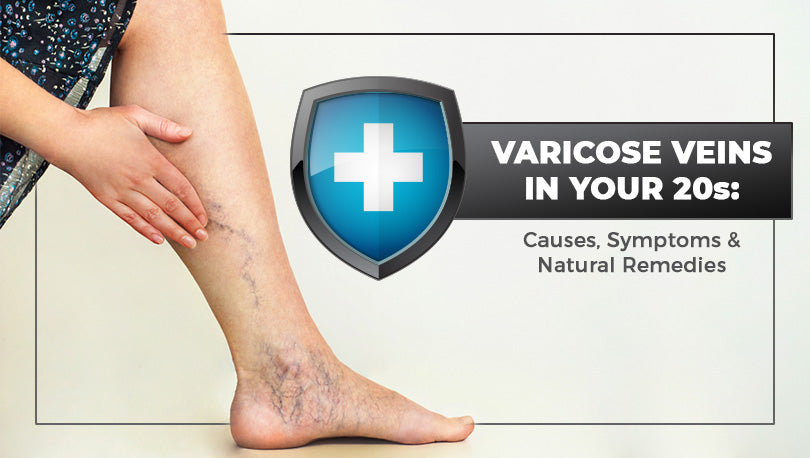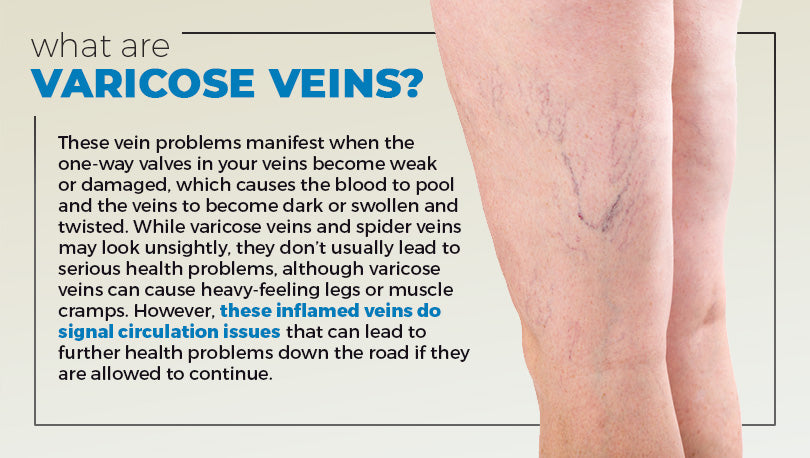
Varicose Veins in Your 20s: Causes, Symptoms & Natural Remedies
While varicose and spider veins are more likely to develop after the age of 50, especially in women, plenty of young people find themselves developing varicose veins as early as their 20s. Thankfully, there are many lifestyle changes young people can make at home to either prevent or treat the appearance of varicose and spider veins.
Read on to discover symptoms and causes as well as natural and medical varicose vein treatments.
What Are Varicose and Spider Veins?
The Office of Women’s Health defines varicose veins as “twisted veins that can be blue, red or skin-colored. The larger veins may appear ropelike and make the skin bulge out.” Varicose veins usually appear on the thighs, the backs and fronts of the calves or the inside of the legs near the ankles and feet. However, pregnancy may cause them to manifest in other places as well, such as the inner thigh, lower pelvic area and buttocks.
Spider veins, also known as thread veins, are smaller than varicose veins, as their name suggests. They are usually red and often look like spider webs, hence their name. Oftentimes spider veins can be seen under the skin, but they don’t bulge, which is what distinguishes them from varicose veins. Spider veins typically appear on the legs or face.

These vein problems manifest when the one-way valves in your veins become weak or damaged, which causes the blood to pool and the veins to become dark or swollen and twisted. While varicose veins and spider veins may look unsightly, they don’t usually lead to serious health problems, although varicose veins can cause heavy-feeling legs or muscle cramps. However, these inflamed veins do signal circulation issues that can lead to further health problems down the road if they are allowed to continue.
So if you have varicose or spider veins, don’t ignore them! They’re a symptom of a much larger problem.
Symptoms to Watch Out For
First off, it’s helpful to know how to spot varicose and spider veins. You usually won’t be able to see healthy veins through your skin — or if you can see them, they should be very faint. If you notice some veins that are a dark blue or red, that’s a sign that you might be developing spider or varicose veins. And while varicose veins may also be skin-colored, they often make the skin bulge out — another telltale symptom that’s very easy to spot.

While people don’t usually feel spider veins, varicose veins may make your legs feel heavy or your skin feel tight or itchy. They may even cause pain or cramps in the calves, especially during the night. In fact, varicose vein symptoms often get worse toward the end of the day and are exacerbated by long periods of standing or sitting. The appearance of varicose veins isn’t necessarily related to how they feel: Large, bumpy, unsightly veins may not cause any discomfort whatsoever, while small, flat veins can be very painful.
Even if the varicose or spider veins are purely a cosmetic concern, many people still find their lives affected by them. They may not want to wear shorts or a skirt in public, for example, or they may avoid activities that would require them to expose their legs.
Even if your veins don’t cause you any pain, if they affect your quality of life, it’s still worth looking into treating them, especially since they will progress if you don’t make some lifestyle changes to address your symptoms.
Causes and Risk Factors
Certain factors do increase your chances of developing varicose and spider veins. Heredity is a major contributor, so if your parents or grandparents have venous issues, that increases your odds of developing them too, even if you’re young.
Pregnancy is also a known cause of venous issues, and since the average age of having a first child is 26.3 years for American women, that means plenty of ladies in their 20s are at risk of developing varicose veins. Being overweight or obese can also lead to varicose or spider veins, as extra pounds put direct pressure on your veins. According to the Centers for Disease Control and Prevention, 35.7 percent of young adults in the U.S. aged 20 to 39 years are obese as defined as having a BMI of 30 or higher, so the venous issues caused by being overweight are a serious concern for young people.

A lack of movement — whether that’s standing, sitting or lying down for long periods — can also contribute to the development of venous problems. That’s because gravity constantly pulls on your blood, putting pressure on your veins and causing blood to pool in your legs and feet regardless of your position. This means that standing or sitting all day for work can lead to venous issues, as can long commutes and frequent travel, which also require you to sit still for long periods. Wearing tight clothing can cut off your blood flow, and wearing high heels frequently puts a lot of pressure on the veins of your lower legs.
Other factors that affect your level of activity — and that can therefore contribute to varicose and spider veins — are a generally sedentary lifestyle, being on bed rest for a long period and sustaining an injury that requires curtailing your level of physical activity.
Medications that affect your circulation may also play a role in the development of varicose and spider veins. In addition, anyone who has previously had a blood clot in their veins — known as DVT, or deep vein thrombosis — is also at risk for long-term venous problems, including varicose and spider veins.
So how do you improve venous blood flow in your legs to try and avoid these problems? Read on to discover eight natural strategies that you can try at home.
Prevention and Treatment Tips
Whether you already have varicose veins in your 20s or you’re just looking to prevent them from manifesting, there are thankfully many natural remedies that you can try at home. Use a combination of these strategies, or even try them all, for the best results.
- Elevate Your Legs: When you’re upright, gravity is constantly pulling your blood towards your feet — but if you lie down with your feet at about the level of your heart, you can actually harness the power of gravity to counteract its usual effects. For optimal results when elevating your legs, lie down flat on a bed or couch with your legs at the following angles: 45 degrees for your thighs, 20-30 degrees for your knees, and 15-20 degrees for your calves. If this sounds too complicated, a leg elevation pillow can help you get set up properly with hardly any effort. Lie down in that position for 15-20 minutes at the end of your day to encourage blood and other fluids to flow back towards your core.

- Wear Compression Socks: You can also fight the effects of gravity while you sit and stand by wearing compression socks or stockings. These garments are made of a special fabric that provides graduated, tapered pressure up the leg, gently squeezing your veins with just the right pressure to encourage your blood to keep flowing. Compression socks are available in a variety of colors and styles that go with every outfit.
- Avoid Constricting Clothes: Other than compression socks that are specially designed to provide non-restricting pressure, you should avoid tight clothes that cut into your skin, hamper your range of movement or otherwise compromise your circulation. Instead, opt for loose, breathable clothes that allow you to move freely and don’t chafe or cut when you bend over and sit down. If you need to wear something more fitted, look for stretchy, flexible fabrics that will move with you and allow for full circulation.
- Take Walking Breaks: If you sit or stand most of the day without moving, incorporate walking breaks into your schedule so you can help get your blood flowing and reverse some of the effects of gravity. Even if the walk is just down the hallway and back, it’s still better than sitting there like a bump on a log. If you’re trapped in meetings all day, you can still stretch your legs, wiggle your feet and pump your calves to add a little bit of movement to your day.

- Start an Exercise Routine: Working out is an important component of a healthy lifestyle, and it can help combat the development of varicose and spider veins. Exercise works to improve your circulation by moving your body and causing your heart to pump, which physically moves the blood through your body. Exercise can also help you lose weight or maintain a healthy size, which can further prevent varicose and spider veins.
- Eat a Healthy Diet: Speaking of managing your weight, eating a healthy diet also plays an important role in losing or maintaining weight. While there are many different diet variations out there, in general a healthy meal plan should focus on vegetables, fruits, whole grains, low-fat dairy and lean meats while minimizing sugar and fats. Also watch your portion sizes, as certain foods can contain unhealthy amounts of calories and fats if eaten in large quantities.
- Inspect Your Medications: If you’re regularly taking any medications, you should read the labels and check with your doctor to see if any of them might impact your circulation, even if that’s not their primary purpose. For example, certain types of birth control pills can contribute to your risk of developing a blood clot even though they don’t directly cause clots. Your medication is probably fine, but it’s always worth it to check, especially if you already have a family history of venous issues such as varicose and spider veins.
- Use Makeup or Self-Tanning Lotion: This strategy won’t actually treat or prevent varicose veins, but if you’re self-conscious about their appearance and have a big event coming up — and you can’t wear compression tights or pants — you can temporarily minimize the look of your veins by using makeup or self-tanning lotion. If you opt for the tanning route, just make sure you don’t do it the natural way and lay out in the sun for hours: Exposure to the sun can actually increase the appearance of spider veins because the UV rays break down the collagen (or connective tissue) in the skin, decreasing pressure on the veins and making them more visible.
Medical Options
If your varicose veins are already severe, there are several medical treatment options that you can look into. Most experts recommend waiting until you are done having children before pursuing these treatments, as pregnancy is a known cause of varicose and spider veins.
Varicose veins can happen at any age, especially in your 20s, even though the condition is more likely to manifest during or after middle age. If you’re a young person at risk for developing varicose and spider veins, follow these natural tips to help prevent and treat these venous problems.




